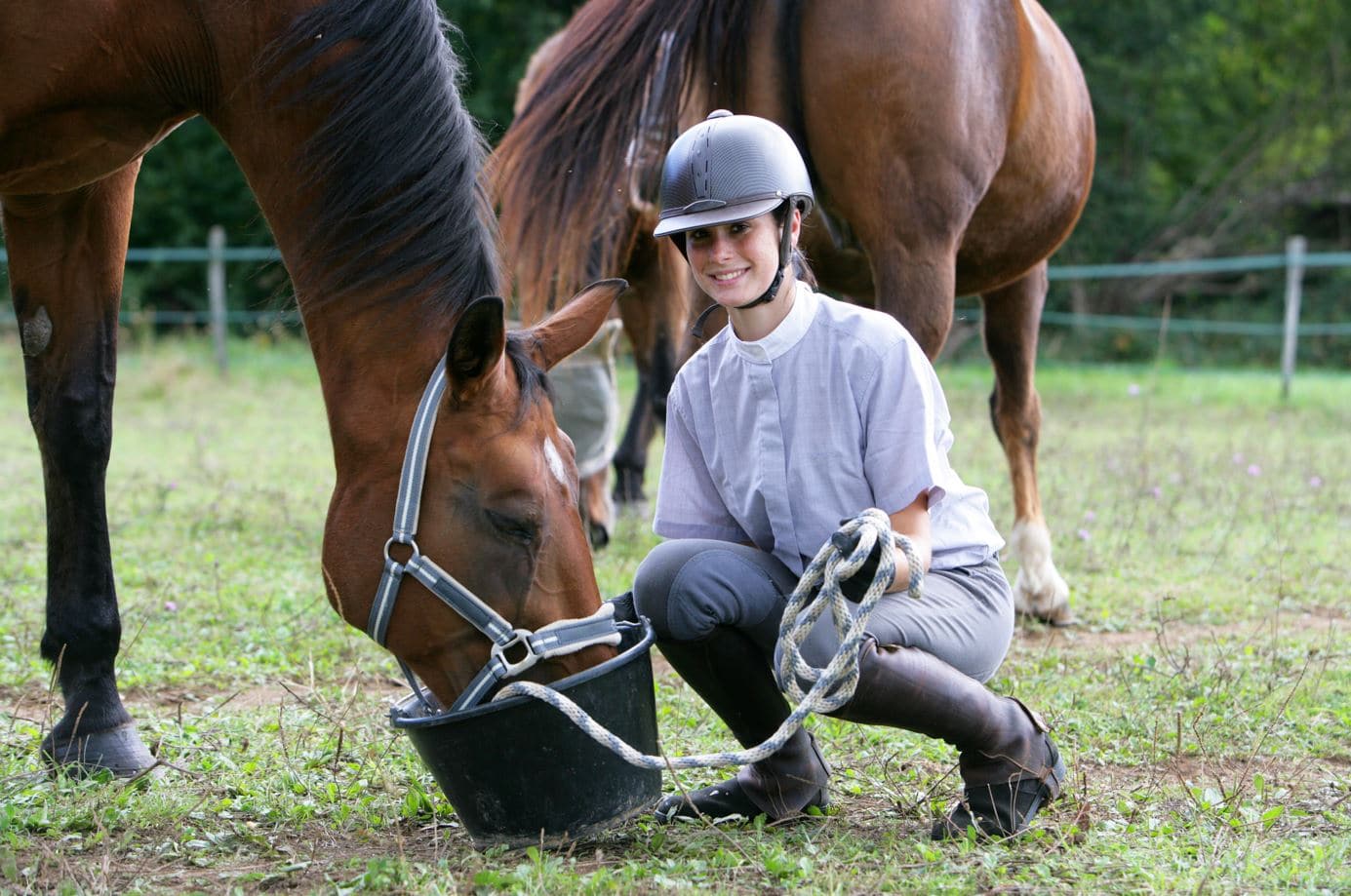Adapting the diet of horses to their age, metabolism and activity is essential to ensure the balance of the intestinal and digestive system and to maintain their good health.
UNDERSTAND YOUR HORSE’S DIGESTIVE SYSTEM IN ORDER TO FEED IT PROPERLY.
There are many opinions on how and what to feed horses. Each rider, trainer or groom has their own opinion on how to feed them. Frequently, feeding practices are inappropriate due to a lack of understanding of how the horse’s gastrointestinal system works. They can even quickly create health problems.
We will provide an explanation of some of the anatomical and physiological aspects of the horse, including the shape and function of the digestive system. This will help you understand the best way to feed your horses. But also, it will help you to reduce or avoid certain health problems.
The horse is a herbivore. Under natural conditions the horse feeds on grass, and this keeps him busy between 12 and 20 hours a day. The capacity of its stomach is limited.
Comparing the size of a horse with the size of its stomach, the stomach is considered small (10% of the total digestive system). This allows the horse to eat small portions several times a day. When in a stable, its feeding behavior is modified according to the animal’s condition, training time, etc.
THE DIGESTIVE TRACT OF THE HORSE
The mouth
The mouth is the beginning of the digestive system, and allows the capture and the gripping of food thanks to the lips, mainly thanks to the upper lip. Very vigorous, the lip is also mobile and sensitive and brings to the incisive teeth a precious help before the chewing.
Teeth are very important as they are responsible for grinding food ingredients. They allow the nutrients to be exposed and absorbed in the different stages of the digestive system.
They give the necessary size to the feed to avoid the horse’s colic problems. If the horse has dental problems, you will start to notice that the feed is excreted “whole” without major changes. This can cause weight loss and a decrease in the horse’s performance.
The esophagus
The esophagus is a tubular organ with movements called peristalsis through which food passes into the stomach.
The stomach
As mentioned above, the horse’s stomach has a very small capacity, 15 to 18 liters. It is usually only 2/3 full, or 10 to 12 liters. This justifies the need to distribute the food throughout the day.
Enzymatic digestion begins in the stomach thanks to the active principles of gastric juice (pepsin and hydrochloric acid). They lower the pH of the stomach contents. If the food remains in the stomach for the necessary time, this can trigger the hydrolysis of plant proteins.
Forages do not undergo major changes in the stomach. The conditions do not allow the proliferation of bacteria that degrade easily fermentable starches and sugars, which produce different types of volatile acids (used as energy source). It is therefore interesting to improve the gastric digestion of concentrates.
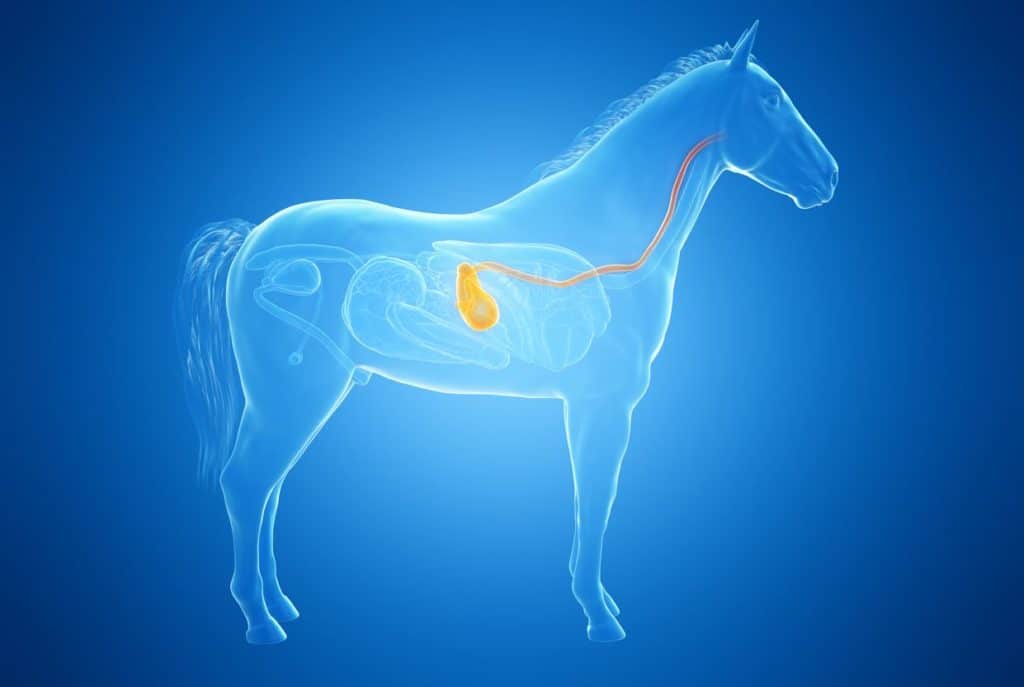
Feed rich in cellulose (forage) will not be attacked by the fermentative microflora, except in the large intestine. For this reason, it is practical to feed the forage first, then the feed. Adequate saliva production and sufficient amounts of feed will help to reduce the risk and problems of gastric ulcers.
Small intestine
The small intestine is 16 to 24 meters long with a capacity of 60 liters. Nutrients are absorbed by the intestinal villi and pass into the bloodstream.
Digestion in the small intestine takes only a few hours. It is enzymatic in nature and does not affect the cellulose. It is mainly the constituents of concentrated food that are digested:
- sugars
- lactose
- starch
- fats
- nitrogenous materials (especially proteins)
The enzymes amylase, lactase, maltase, protease and peptidase are those that release the different nutritional elements of food. They provide nutritional energy elements that can be used by the body. In general it is said that they can provide 30 to 60% of the total energy absorbed. The nitrogenous nutritional elements (amino acids) can provide 30 to 80% of the total nitrogenous matter.
The percentages increase with the concentrate content of the ration. Minerals are absorbed by the small intestine, except for phosphorus.
The large intestine
This is the largest compartment, 180 to 220 liters divided between the cecum, the colon (major and minor) and the rectum. It is always full. In principle, the feed is digested in the large intestine.
Digestion in the large intestine takes at least 24 hours. The digestion of the undigested components of the small intestine is ensured by prolonged fermentation. It is carried out by the very active microbial population present in the cecum and the colon. The plant walls and a reduced fraction of the reserve sugars are transformed into energy (volatile fatty acids) and nitrogen (amino acids) nutrients.
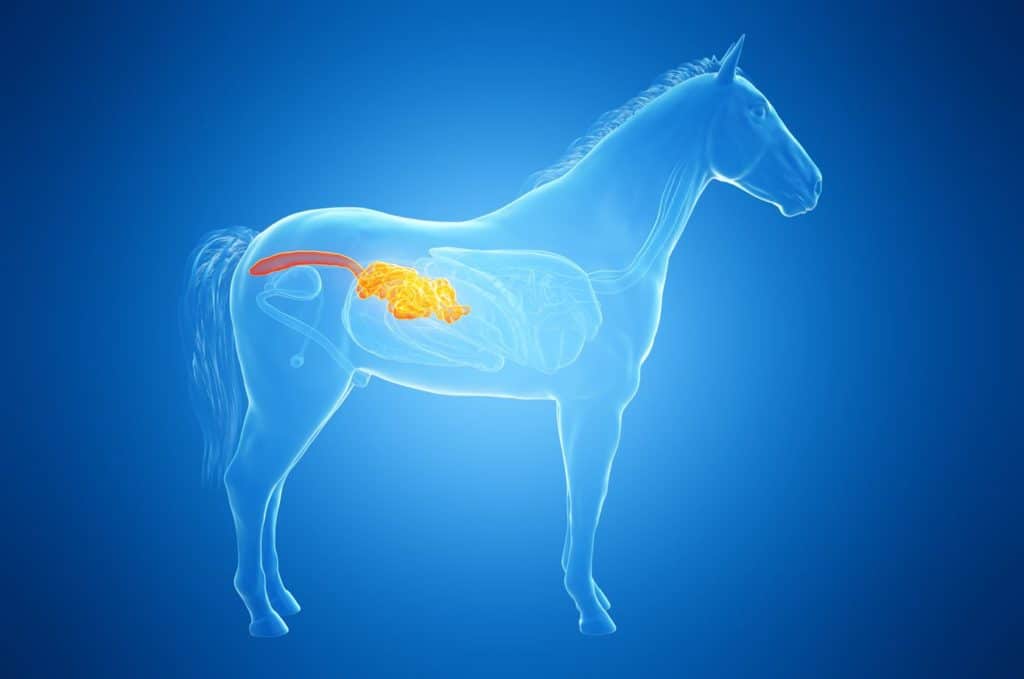
In diets rich in forage, volatile fatty acids can provide up to 2/3 of the total energy absorbed in the digestive tract. In addition, certain B vitamins (B1, B6, B12) and vitamin K are synthesized in the large intestine. Phosphorus is also absorbed in the large intestine.
THE NUTRIENTS WE NEED TO PROVIDE TO HORSES: WATER, ENERGY, PROTEINS, CARBOHYDRATES, FATS, VITAMINS AND MINERALS
The water
Water is the most important nutrient. A horse can live for several weeks without food, but two or three days without water can lead to serious complications and even death. On average, a 500 kg horse consumes about 20 to 30 liters of water per day.
It is important to note that the horse must have a fresh, clean source of water available at all times. Water consumption varies from horse to horse and not all horses consume the same amount. In hot climates, water consumption increases considerably, as does that of horses that sweat a lot or of mares that are lactating.
Electrolyte supplementation will increase water intake. Generally this supplementation is not necessary unless the horse is sweating heavily. Sweat contains large amounts of electrolytes such as sodium, chlorine, potassium, and small amounts of calcium and magnesium. These electrolytes must be replaced if the horse sweats a lot.
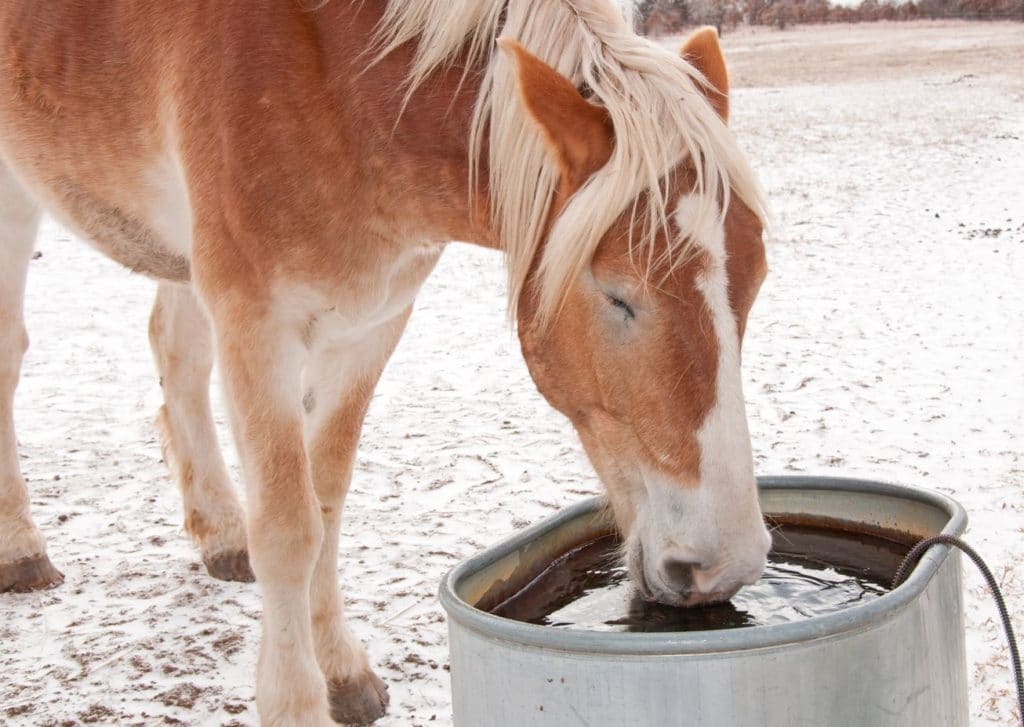
Why add white salt?
Some horses will not drink the water if electrolytes are added (due to the change in taste). If electrolytes are added to the water, it is important to also offer water without electrolytes. This will prevent dehydration. White or common salt (also called cooking salt) can be offered at any time or added to the food ration. Other electrolytes such as potassium, calcium and magnesium are normally present in sufficient quantities in the diet. Therefore, it is not necessary to supplement them in horses that normally sweat.
The proteins
Protein is composed of molecules called amino acids. There are 22 amino acids that make up protein. When digested, proteins release amino acids that are absorbed. These amino acids are needed to build new proteins, such as muscle tissue. The amino acid lysine, also called essential, is very important because it is needed for multiple processes in the body. A 500 kg horse needs an average of 23 grams/day.
The most important thing about protein is not its quantity but its quality, which is given by the amino acids that compose it. Using a concentrate with a certain percentage of protein (12% or 16%) doesn’t say much because you need a certain amount of grams to cover your needs instead of a certain percentage. You need to know the total amount of protein you are providing, the amount (not the percentage) contained in the daily ration of grain and forage that your horse consumes in relation to its needs. For example, a 500 kg horse needs 665 grams/day of protein in its diet.
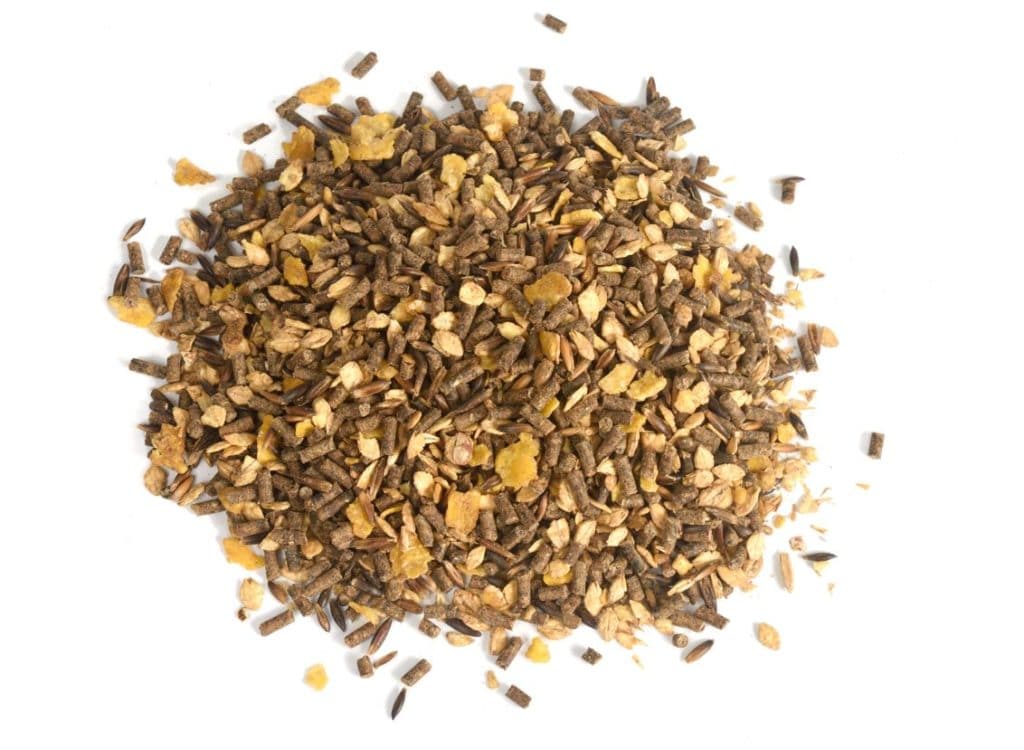
Carbohydrates
Carbohydrates can be simple (also called soluble carbohydrates or monosaccharides), such as glucose and other sugars, or complex, such as starch, fiber, and the less soluble portions of grains. Cereals contain both carbohydrates, soluble (in the inner part of the seed) and insoluble (the outer parts of the seed and plant parts). Cereal products are also called concentrates and are composed of more soluble carbohydrates than forage.
The digestibility of grains is also affected by processing. For example, rolled oats or broken corn contain soluble carbohydrates that are more available to the digestive process than if they were whole grains. Most soluble carbohydrates are digested and absorbed in the small intestine, while insoluble carbohydrates pass into the colon and cecum to be fermented by bacteria that produce volatile fatty acids. Glucose and volatile fatty acids are used by the horse to produce energy or are stored in various tissues as fat reserves for further energy production.
Fats
Fats are digested and absorbed in the small intestine. They can be used for energy production or stored as an energy reserve for a relatively long time.
Recent research has shown that fats can provide up to 10-20% of a horse’s daily energy requirements. In the case of horses suffering from muscular disease problems or Monday’s disease/blood disease/myositis…), they can benefit significantly by decreasing the amount of soluble carbohydrates (grain ration) in their diet by increasing the amount of energy provided by fat. The same amount of fat has the ability to produce twice as much energy as soluble carbohydrates or protein, gram for gram.
Vitamins
It is important to include vitamins in the horse’s diet.
Some vitamins are sensitive to sunlight, heat and oxidation (especially vitamins A and E). Hay stored for a year or more, and hay that has been rained on between harvest and packaging, may have lower concentrations of these vitamins. In addition, the pelleting process for many products involves heat and pressure. Therefore, it is important to know if the vitamins are supplemented and how they should be added to horse feeds.
The most commonly added vitamins needed by the horse are vitamin A (important for reproduction), vitamin E (a natural preservative and antioxidant, which ensures optimal function of the reproductive, muscular, circulatory, nervous and immune systems), vitamin H (also known as biotin, which helps improve hoof and coat quality and is necessary for fat, protein and glucose synthesis). Horses that do not have access to fresh pasture during the winter months (or all winter) have been shown to be significantly deficient in vitamin E during those months.
These vitamins are added to processed foods or can be provided in the form of food supplements.
The minerals
Minerals are relatively stable during food processing, but the concentration of a particular mineral in a plant is proportional to the concentrations in the soil. For example, it is well known that selenium-deficient forage can be produced in certain regions. Therefore, it is important to know if you are in a geographic area that requires selenium supplementation. Minerals commonly added to balanced foods are calcium, phosphorus, copper, zinc and selenium.
Selenium deficiency can cause muscle disease in both young and adult horses. Check with your veterinarian if you need selenium supplementation, as the difference between required and toxic levels is very small. Be careful and avoid using multiple selenium-containing supplements; this can cause inadvertent toxicity. This is true of all supplements, so check carefully what they contain and how much to ensure the horse is getting only what it needs.
| Cereals (%) | Forage (%) | |
| Young horses | 60 | 40 |
| Service horses | 30 | 70 |
| High performance horses | 50 | 50 |
The importance of nutrients in horse nutrition
The British Society of Nutrition defines the word “Nutrition” as “the sum of all the processes from the intake of nutrients to their absorption and subsequent use” (BESM 1994).
This means that each horse can absorb and use nutrients more or less efficiently. An optimal diet for one horse may not work for another horse because the systems do not use the calories provided in the same way.
It is therefore necessary to observe the horse’s health, energy level, weight and coat quality, competition performance, physical weaknesses and adjust the diet if necessary. Whatever your activity and the level of energy required by your horse, the solution can be found in the Royal-Horse feed range.
